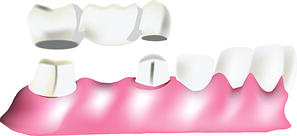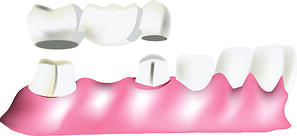What Is A Dental Bridge


Dental bridges are used to bridge the gap caused by a missing tooth or multiple teeth. A dental bridge consists of a false tooth (called a pontic) fixed between two crowns. These two crowns will be attached to the healthy teeth that abut the gap caused by a missing tooth. The crowns will act as anchors and secure the false tooth into place.
When placing a dental bridge in a patient’s mouth, the area must first be prepared by contouring and reshaping the existing teeth so that the crowns can fit correctly on top. Then the bridge, consisting of the pontic and two crowns, will be secured over the healthy teeth, placing the false tooth in its proper location. By securing the false tooth to healthy teeth, the dental bridge becomes a long-lasting and durable solution to missing teeth.
It will take several dental visits for the finished dental bridge to be completed and cemented into place. A dentist will start by taking x-rays and preparing the surrounding teeth by removing some of the tooth structure to make room for the crowns. The dentist will then take impressions of the newly contoured teeth for the permanent bridge. While the permanent bridge is being created a temporary bridge will be put in place to protect the exposed teeth and gums. Once the permanent bridge has been made, the dentist will then remove the temporary bridge and cement the permanent one in its place. Once the bridge is in, it may take another visit to the dentist to make sure the bridge is perfect and is not affecting the patient’s bite.

The false tooth can be made of many different types of materials, including gold, porcelain, plastic, alloys, or sometimes a combination of those materials. A properly constructed dental bridge will improve a person’s ability to speak and chew, and it will keep the rest of the teeth from moving out of position. Missing teeth can cause a variety of problems such as temporomandibular joint disorder (TMJ), speech problems, and pain.
There are a few different kinds of dental bridges. The traditional bridge is described above, but there are also cantilever bridges, which are used when there is only an adjacent tooth on one side. Another type of bridge is the Maryland bonded bridge, which uses a metal framework to bond the false tooth to the existing teeth and a plastic or ceramic material for the false tooth. This requires minimal preparation.
Dental bridges are permanent and cannot be removed without the help of a dentist. However, once in place and properly maintained with brushing and flossing, a dental bridge can last up to a decade. A dentist will advise on the proper maintenance of a dental bridge and will advise their patients on using special floss to help keep the area clean. Dental insurance will usually cover at least part of the cost of the procedure, making it a sound investment.
Source: http://findmydentist.com/articles/crown-and-bridge-dental-work.html


